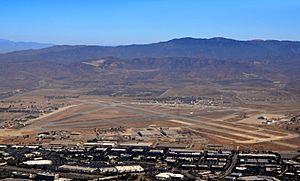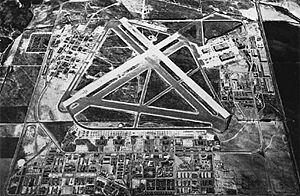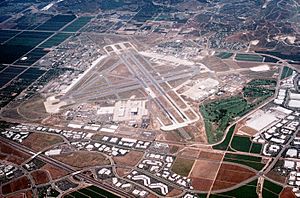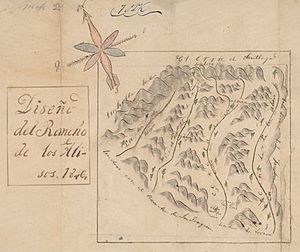Marine Corps Air Station El Toro facts for kids
Quick facts for kids
MCAS El Toro
|
|||||||||||||||||||||||||||
|---|---|---|---|---|---|---|---|---|---|---|---|---|---|---|---|---|---|---|---|---|---|---|---|---|---|---|---|

MCAS El Toro in 2010
|
|||||||||||||||||||||||||||
| Summary | |||||||||||||||||||||||||||
| Airport type | Military | ||||||||||||||||||||||||||
| Operator | United States Marine Corps | ||||||||||||||||||||||||||
| Location | Orange County, California | ||||||||||||||||||||||||||
| Built | 1942 | ||||||||||||||||||||||||||
| In use | 1943–1999 | ||||||||||||||||||||||||||
| Occupants | 3rd Marine Aircraft Wing | ||||||||||||||||||||||||||
| Elevation AMSL | 383 ft / 117 m | ||||||||||||||||||||||||||
| Coordinates | 33°40′34″N 117°43′52″W / 33.67611°N 117.73111°W | ||||||||||||||||||||||||||
| Runway | |||||||||||||||||||||||||||
|
|||||||||||||||||||||||||||
|
Source: Federal Aviation Administration
|
|||||||||||||||||||||||||||
Marine Corps Air Station El Toro was a large military airport for the United States Marine Corps. It was located near Irvine, California.
Before it closed in 1999, it was a very important base for Marine Corps planes on the West Coast. It covered about 4,682 acres (19 square kilometers). The base had four long runways, two of them 8,000 feet (2,438 meters) long and two 10,000 feet (3,048 meters) long. These runways were big enough for the largest planes in the U.S. military.
During its active years, every U.S. President after World War II landed at El Toro in Air Force One. The base's "Flying Bull" symbol was designed by Walt Disney Studios in 1944. This symbol stayed almost the same until the base closed.
After closing, parts of the base were used for filming movies and TV shows. It even became a test track for the U.S. version of the TV show Top Gear. About 1,300 acres (5.3 square kilometers) of the land became a huge park called the Orange County Great Park. The rest of the land was planned for homes and businesses.
Contents
History of MCAS El Toro
How the Air Station Started
In May 1942, during World War II, Lieutenant Colonel William Fox chose locations for new Marine Corps air stations on the West Coast. He looked for places that were easy and cheap to build on. For the fourth station, he picked land that the United States Navy had already considered for a blimp base.
The Marine Corps bought 4,000 acres (16 square kilometers) of land from a farmer named James Irvine Sr. They paid him $100,000. This land used to be a huge lima bean field, which was very important for Irvine's business. Construction of the base began on August 3, 1942. The name "El Toro" came from a small nearby town.
Early Days and Growth
The base headquarters was set up on November 4, 1942. The first plane landed there by accident in late November when a pilot had to make an emergency landing. The runways were finished by December 1942, and all the plane hangars were ready by January 1943.
The first military units arrived in January 1943. Some of these units were returning from fighting in the Guadalcanal Campaign and needed to get new equipment and train. The station officially opened on March 17, 1943. Soon after opening, MCAS El Toro became one of the busiest airfields on the Pacific Coast.
By the end of 1944, the base had grown a lot. It was home to over 1,200 officers and 6,800 enlisted Marines.
El Toro as a Master Jet Station
In 1950, El Toro was chosen to be a permanent "Master Jet Station" for the Marine Corps in the Pacific. This meant it would be a main base for jet aircraft. To support this, the base's aviation facilities were greatly expanded.
For many years, El Toro was the main base for Marine Corps fighter squadrons on the West Coast. In the 1960s, many U.S. Marines traveled through El Toro MCAS when going to and from Vietnam. In 1958, the 3rd Marine Aircraft Wing moved to El Toro.
Presidential Visits and Closure
During the time Richard Nixon was president, MCAS El Toro was often used for flights to and from his "Western White House" in San Clemente, California. On August 9, 1974, after resigning as president, Richard and Pat Nixon flew from Maryland to El Toro on Air Force One.
When the base first opened, the land around it was mostly farms. But in the late 1980s and early 1990s, homes started to be built nearby. This caused problems because the loud noise from jets and helicopters was very annoying to the people living there.
In 1993, MCAS El Toro was chosen to be closed by the Base Realignment and Closure Commission. All its activities were moved to Marine Corps Air Station Miramar. The station officially closed on July 2, 1999.
Cleaning Up the Base
Before the land could be used for other things, the United States Department of the Navy had to clean up any pollution. The pollution was caused by chemicals called volatile organic compounds (VOCs). These chemicals were used over the years for cleaning planes and other equipment.
These chemicals had soaked into the groundwater (water under the ground). This created a plume of polluted groundwater that stretched for three miles (5 kilometers) west of the base. By July 2005, the Navy announced that the cleanup of the polluted soil was finished.
The cleanup of the groundwater is being handled by a project called the Irvine Desalter Project. This project gets money from the Navy and the State of California.
Sale of El Toro Land
The Navy hired companies to help sell the land of the former MCAS El Toro. In February 2005, the land was sold for $650 million to a group of companies called Heritage Fields LLC.
The plans for the 3,724-acre (15 square kilometers) site include building homes, a golf course, businesses, research areas, and schools. About 1,375 acres (5.6 square kilometers) of the site became the Great Park. The official transfer of the land happened on August 29, 2005.
Accidents and Incidents at El Toro
- On June 25, 1965, a U.S. Air Force Boeing C-135A plane crashed right after taking off from MCAS El Toro. All 84 people on board died.
- On January 23, 1967, two Skyhawk jets collided in the air during a rainstorm. Both pilots ejected from their planes. One pilot landed safely, but the other died after his parachute caught on a building.
- On July 30, 1970, a KC-130F plane crashed and burned during a landing, killing 4 of the 5 crew members.
- On June 6, 1971, a McDonnell Douglas DC-9 passenger jet and a Marine Corps F-4B Phantom fighter jet collided in the air. This accident caused 50 deaths. One of the Marines in the fighter jet survived.
- On July 4, 1986, a 21-year-old Marine mechanic, Howard Foote Jr., took an A-4 Skyhawk jet for an unauthorized flight. He was sad because a medical issue meant he couldn't fly in the Marines. He landed the plane safely and was later discharged from the Marines.
- On February 12, 1987, a Boeing Vertol CH-46 Sea Knight helicopter crashed shortly after takeoff. All three crew members died.
- On April 24, 1988, Marine Corps Colonel Jerry Cadick crashed his F/A-18 Hornet jet during an air show. He was flying too low during a loop. He survived but was seriously injured.
- On May 2, 1993, during the 1993 MCAS El Toro airshow, an F-86 Sabre jet crashed on the runway. The pilot died, but no one on the ground was hurt.
Notable Events at El Toro
- The MCAS El Toro Air Show happened every year from the 1950s until 1997. It featured famous flight teams like the U.S. Navy Blue Angels and the United States Air Force Thunderbirds. New aircraft, like the B-2 stealth bomber, were also shown. The last air show in 1997 had about two million visitors.
- MCAS El Toro was often used for flights by President Richard Nixon when he visited his home in San Clemente, California. He landed there in Air Force One after resigning as president in 1974. His body was also flown there in Air Force One after his death in 1994 for burial.
- In 2006, an old F-18 hangar at El Toro was turned into a giant pinhole camera. It created a huge panoramic photo of the air station on a special cloth. This image, called “The Great Picture,” is believed to be the largest photo ever taken by a camera.
- From 2005 to 2012, the new Orange County Great Park hosted small air shows, fireworks, and other family events.
See also
 In Spanish: Estación Aérea del Cuerpo de Marines de El Toro para niños
In Spanish: Estación Aérea del Cuerpo de Marines de El Toro para niños




